夏の夜空を彩る花火、賑やかな縁日のざわめき。そんな日本の夏の情景に、欠かせないのが「浴衣」の存在です。涼しげで華やかな浴衣は、今や夏のファッションとして多くの人に親しまれていますが、そのルーツが、かつて貴族たちがお風呂で着ていた「サウナ着」にあったことはご存知でしょうか。
浴衣の歴史は、日本の入浴文化の変遷そのもの。湯上がり着からおしゃれな外出着へ。時代と共にその役割を変えてきた浴衣の、知られざる物語を紐解いていきましょう。
- 貴族専用の「サウナ着」だった?平安時代の「湯帷子(ゆかたびら)」が原点。
- 江戸の銭湯ブームが火付け役!風呂上がりのリラックスウェアから一大ファッションへ。
- 盆踊りと木綿の普及が後押し、浴衣文化が庶民の間で花開く。
すべては蒸し風呂から始まった 貴族たちの湯帷子
浴衣の原型は、遠く平安時代にまで遡ります。その名は「湯帷子(ゆかたびら)」。現代のように湯船に浸かる入浴スタイルがまだなく、複数人で入る蒸し風呂(現在のサウナのようなもの)が主流だった時代、貴族たちは汗取りや火傷防止、そして裸を隠す目的で、風通しの良い麻で仕立てた単衣(ひとえ)の着物をまとっていました。これが、湯帷子です。
文字通り「湯の中で着る帷子(麻の着物)」であったこの衣服は、あくまで入浴時に着用するものであり、身分の高い人々だけが使用できる特別なものでした。現在の浴衣のイメージとは異なり、機能性を重視した実用着だったのです。
風呂上がりの粋な姿 安土桃山から江戸の社交場へ
時代は進み、安土桃山時代になると、入浴後の汗を吸い取り、肌を快適に保つ目的で、湯上がりに木綿の着物を着る習慣が生まれます。この「湯上がり着」こそが、現在の浴衣の直接の祖先と言えるでしょう。この頃から、素材も麻から吸水性の良い木綿へと変わっていきました。
そして江戸時代、日本の入浴文化に革命が起こります。各地に「銭湯」が登場し、庶民にとって手軽な娯楽であり、大切な社交の場として爆発的に普及したのです。人々は風呂上がりに浴衣をまとい、縁台で涼みながら会話を楽しむようになりました。この「銭湯」という文化が、浴衣を一部の人の湯上がり着から、庶民の生活に根付いたリラックスウェアへと進化させる大きなきっかけとなりました。
銭湯から祭りへ 浴衣、夏の主役に躍り出る
江戸時代中期、浴衣はさらに大きな転換点を迎えます。それまで貴重品であった木綿の生産技術が向上し、安価で丈夫な木綿地が大量に出回るようになったのです。これにより、庶民も気軽に浴衣を手にすることができるようになりました。
藍染めをはじめとする様々な染色技術も発展し、人々は個性的な柄の浴衣でおしゃれを楽しむようになります。そして、夏の風物詩である「盆踊り」が庶民の間で大流行したことが、その人気を決定づけました。揃いの浴衣で踊ることは粋の極みとされ、浴衣は単なる湯上がり着から、人々が集う夏のイベントに欠かせない「外出着」へと、その地位を確立したのです。
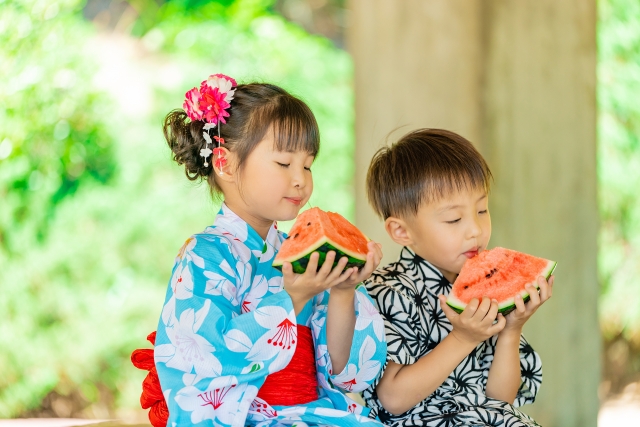
現代に息づく浴衣の心
明治時代以降も、浴衣は夏の普段着として広く国民に愛用され続けました。そして現代、洋服が生活の中心となる中で、浴衣は日常着から「夏という特別な季節を楽しむためのハレの日の衣装」へと、その役割を少し変えながらも、私たちの生活に深く根付いています。
古典的な柄からモダンでポップなデザインまで、その表現はますます豊かになり、世代を超えて愛されるファッションアイテムとなりました。浴衣一枚に込められた、日本の生活文化の長い歴史に思いを馳せながら、今年の夏を楽しんでみてはいかがでしょうか。
解説ポイント①:貴族専用の「サウナ着」だった?平安時代の「湯帷子(ゆかたびら)」が原点
浴衣の最も古い形である「湯帷子(ゆかたびら)」は、平安時代の入浴習慣と密接に結びついています。当時の入浴法は、寺院などに設けられた「湯屋」での蒸気浴が基本でした。
- 入浴法: 湯気が立ち込める室内に複数人が同時に入り、汗を流して体の垢をこすり落とすスタイル。
- 湯帷子の役割:
- 火傷防止: 蒸気を送り出す釜の近くは高温になるため、直接肌が触れないように保護する。
- 汗取り: 大量にかく汗を吸い取る。
- エチケット: 他人の前で裸を晒さないための礼儀。
- 素材: 当時は吸湿性と速乾性に優れた「麻」が主流でした。しかし麻は高価な素材だったため、湯帷子を着用できたのは貴族など一部の支配階級に限られていました。
このように、浴衣のルーツは、現代の私たちが楽しむ華やかなファッションとは異なり、蒸し風呂という特殊な環境下での機能的な衣服だったのです。
解説ポイント②:江戸の銭湯ブームが火付け役!風呂上がりのリラックスウェアから一大ファッションへ
江戸時代に浴衣が庶民の間に広まった最大の要因は「銭湯」の普及です。都市部に人口が集中した江戸では、内風呂を持つ家は稀で、多くの人々が銭湯を利用していました。
- 銭湯の役割: 単に体を洗う場所ではなく、地域のコミュニティセンターであり、情報交換や娯楽の場でした。二階には休憩室や碁盤が置かれ、人々は風呂上がりにくつろぎの時間を過ごしました。
- 浴衣の定着: この風呂上がりのリラックスタイムに、人々はこぞって浴衣を着用しました。吸水性が良く、風通しの良い浴衣は、火照った体を冷ますのに最適だったのです。
- おしゃれの対象へ: 銭湯が社交場となるにつれ、人々は他人の目を意識するようになります。「湯屋の二階で着る浴衣こそ粋」という価値観が生まれ、次第に浴衣の柄やデザインが注目されるようになり、ファッションアイテムとしての側面が強まっていきました。
銭湯というインフラと、そこで生まれた庶民の文化が、浴衣を室内着から外へと飛び出す準備を整えさせたのです。
解説ポイント③:盆踊りと木綿の普及が後押し、浴衣文化が庶民に花開く
浴衣が湯上がり着から夏の「外出着」へと完全にその地位を変えた背景には、二つの大きな要因があります。
一つは木綿の大量生産です。江戸時代中期、農業技術と綿織物技術の発展により、木綿が安価に供給されるようになりました。それまで一部の人しか手に入れられなかった浴衣が、一気に庶民にとって身近な存在になりました。これにより、洗い替えに何枚も持つことが可能になり、用途が広がりました。
もう一つが盆踊りの大流行です。盆踊りはもともと先祖供養の行事でしたが、江戸時代には庶民の娯楽として大きなブームとなりました。人々は、地域の仲間や町内会などで揃いの浴衣を作り、それを着て踊りや練り歩きを楽しみました。この「集団で着て楽しむ」という文化が、浴衣を夏のイベントに不可欠なファッションとして定着させ、浴衣の需要をさらに高める結果となったのです。
参考文献
- 浴衣の歴史|KIMONO BIJIN
- 浴衣の歴史を紐解く〜昔の浴衣はバスローブだった?〜 – 銀座もとじ
- 【浴衣の歴史】起源は平安時代!湯上り着から夏の定番着になるまでの変遷をわかりやすく解説 – 京都着物レンタル-咲く都-
- 浴衣の歴史|きものレンタリエのきもの豆知識
<br>
【English Article】
From Bathhouse to Summer Festival: The Untold Story of the Yukata’s Rise
The fireworks that paint the summer night sky, the lively buzz of a street fair—the “yukata” is an indispensable part of these classic Japanese summer scenes. This cool and colorful garment, now enjoyed by many as summer fashion, has a surprising origin: it began as a “bathrobe” worn by nobles in ancient times.
The history of the yukata is intertwined with the evolution of Japan’s bathing culture. Let’s unravel the untold story of this beloved garment, which transformed over time from post-bath wear into a stylish piece of outerwear.
- Its origin lies in the “yukatabira” of the Heian period, a kind of “sauna suit” for the aristocracy.
- The public bathhouse boom of the Edo period acted as a catalyst, elevating it from loungewear to high fashion.
- Spurred on by Bon Odori festivals and the widespread availability of cotton, yukata culture blossomed among the common people.
It All Began in a Steam Bath: The Yukatabira of the Nobility
The prototype of the yukata dates back to the distant Heian period (794-1185). It was called the “yukatabira.” In an era before the modern style of soaking in a bathtub became common, the mainstream form of bathing was in a steam bath, similar to a modern sauna, often shared by multiple people. To absorb sweat, prevent burns, and cover their bodies, nobles wore a single layer of breathable linen. This garment was the yukatabira.
Literally meaning “a linen garment for the bath,” this clothing was strictly for use during bathing and was exclusive to high-ranking individuals. Unlike the modern image of the yukata, it was a functional piece of clothing that prioritized practicality.
A Stylish Post-Bath Look: From the Azuchi-Momoyama to the Edo Social Scene
As time moved on to the Azuchi-Momoyama period (1573-1603), the custom of wearing a cotton garment after bathing emerged, designed to absorb sweat and keep the skin comfortable. This “post-bath wear” can be considered the direct ancestor of today’s yukata. It was around this time that the primary material shifted from linen to highly absorbent cotton.
Then, in the Edo period (1603-1868), a revolution in Japanese bathing culture occurred. Public bathhouses, or “sento,” appeared throughout the country and became immensely popular as an affordable form of entertainment and a vital social hub for the common people. People began to wear yukata after their bath, enjoying the cool evening air and conversation on benches. This sento culture was the major catalyst that transformed the yukata from a simple piece of loungewear for a select few into a garment deeply rooted in the lives of the general populace.
From the Bathhouse to the Festival: Yukata Takes Center Stage in Summer
In the mid-Edo period, the yukata reached another major turning point. Cotton, which had been a valuable commodity, became widely available at low prices thanks to improvements in production technology. This allowed the common people to easily acquire yukata.
Dyeing techniques, such as indigo dyeing (aizome), also developed, and people began to enjoy expressing their individuality through uniquely patterned yukata. Its popularity was cemented by the massive trend of “Bon Odori” summer festivals. It was considered the height of style to dance in matching yukata, and the garment solidified its position as essential “outerwear” for summer events, moving beyond its origins as simple post-bath attire.
The Spirit of the Yukata, Alive Today
Even after the Meiji period (1868-1912), the yukata continued to be widely worn as casual summer clothing. In modern times, as Western clothing has become the norm, the yukata has slightly shifted its role. It is now seen as special occasion wear for enjoying the unique season of summer, yet it remains deeply embedded in our lives.
Its expression has become ever more diverse, with designs ranging from classic patterns to modern, pop-art styles, making it a fashion item loved across generations. Why not enjoy this summer while reflecting on the long history of Japanese life and culture woven into every yukata?
Analysis Point ①: Its origin lies in the “yukatabira” of the Heian period, a kind of “sauna suit” for the aristocracy
The “yukatabira,” the oldest form of the yukata, is closely linked to the bathing customs of the Heian period. The primary method of bathing at the time was steam bathing in “yuya” (bathhouses) established at temples.
- Bathing Method: A style where multiple people would enter a steam-filled room to sweat and scrub their bodies clean.
- Role of the Yukatabira:
- Burn Prevention: To protect the skin from the high heat near the steam-generating kiln.
- Sweat Absorption: To absorb the large amounts of perspiration.
- Etiquette: A matter of decorum to avoid being naked in front of others.
- Material: “Linen” was the mainstream material due to its excellent moisture-wicking and quick-drying properties. However, as linen was expensive, only the ruling class, such as nobles, could afford to wear yukatabira.
Thus, the roots of the yukata were not in the glamorous fashion we enjoy today, but in a functional garment for the specific environment of a steam bath.
Analysis Point ②: The public bathhouse boom of the Edo period acted as a catalyst, elevating it from loungewear to high fashion
The biggest factor in the spread of the yukata among the common people during the Edo period was the proliferation of “sento” (public bathhouses). In a densely populated city like Edo, houses with private baths were rare, and most people used sento.
- Role of the Sento: It was not just a place to wash the body, but a community center, a place for information exchange and entertainment. The second floor often had a rest area with Go boards, where people would relax after their bath.
- Establishment of the Yukata: During this post-bath relaxation time, people universally wore yukata. The absorbent and breathable yukata was perfect for cooling down a warm body.
- Becoming a Fashion Item: As the sento became a social venue, people grew more conscious of their appearance. A new sense of value emerged, suggesting that “the yukata one wears on the second floor of the bathhouse is the epitome of style.” Gradually, the patterns and designs of yukata gained attention, strengthening its aspect as a fashion item.
The infrastructure of the sento and the commoner culture born there set the stage for the yukata to leap from being indoor wear to outdoor fashion.
Analysis Point ③: Spurred on by Bon Odori festivals and the widespread availability of cotton, yukata culture blossomed among the common people
Two major factors were behind the yukata’s complete transformation from post-bath wear to summer “outerwear.”
The first was the mass production of cotton. In the mid-Edo period, advancements in agricultural and weaving technology made cotton inexpensive. The yukata, once accessible only to a few, suddenly became a familiar item for the common people. This allowed them to own multiple yukata for different purposes, expanding its use.
The second was the huge popularity of Bon Odori. Originally a ritual to honor ancestors, Bon Odori became a major form of entertainment for the common people in the Edo period. People in local groups and neighborhoods would have matching yukata made, wearing them to dance and parade. This culture of “wearing and enjoying as a group” firmly established the yukata as essential fashion for summer events, further boosting its demand.

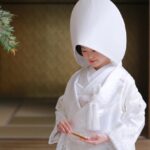
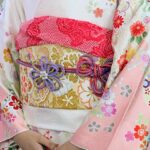
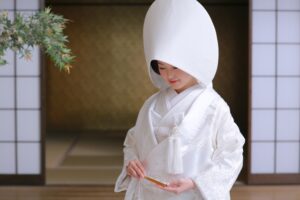
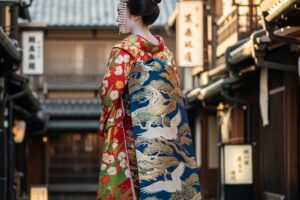

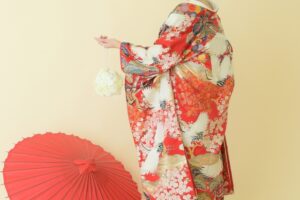
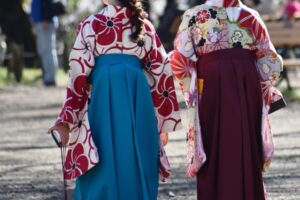
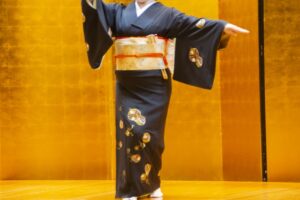
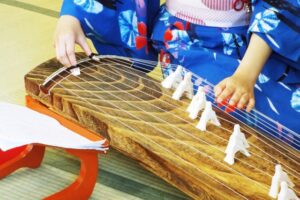
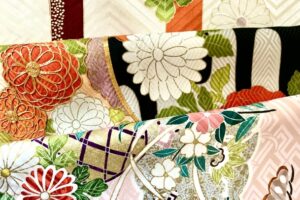
コメントを残す